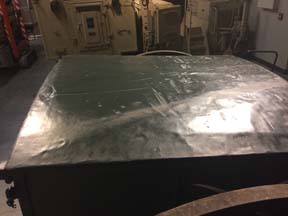This is the Cavalry Forge-Cart, Model of 1874. The intention was that each Cavalry Company
was to have a cart, pulled by a single horse in shafts, carrying the equipment
of the blacksmith and the saddler. In
case of hard going, there was an arrangement to attach an additional horse in
shafts to aid in the transport of this vehicle.
It didn’t exactly work as it was too heavy for one horse and not heavy enough
for two.
Ordnance Memoranda No. 18, SPECIAL ORDERS Nos. 238 And 253,
A. G. 0., 1873, On Horse-Equipments, Cavalry Equipments and Accoutrements, Saddler’s
and Smith’s Tools and Materials, and Standard Supply-Table of Ordnance Stores for
the Cavalry Service, Washington, GPO, 1874, pp. 62-65
RESOLUTION No. 14. Cavalry
forge-cart.
Resolved, That the
Board recommends the adoption of a traveling forge cart to be issued to each company
of cavalry, for the purpose of carrying the blacksmith’s bellows, fire-box, anvil,
coal, blacksmith’s tools, horseshoes, nails, and iron; also for the purpose of carrying
the extra ammunition, saddler’s tools, and supply of leather for the repairs of
horse-equipments. The size of the cart, and the different compartments and their
dimensions, together with the measurements of the bellows and fire-box, to be designated
in the plans and drawings submitted, and suitable harness to be furnished with each
cart.
Pages 141-47 show line drawings of the cart.
Cavalry Cart, Model of 1874, recently acquired by the Field Artillery Museum at Fort Sill, OK.
The 6" X 6" block is modern.
Interior of the lid of the cart.
Markings on the interior of the lid of the cart.
"BUILT WATERTOWN
ARSENAL, MASS
1881"
The lid of the cart from above.
The near side of the cart showing the crossed sabers.
The insulated drinking cup is modern.
Close-up of crossed sabers.
The right front of the cart.
The rear of the cart showing the recess where the blacksmith’s
forge was stored. The forge is
missing. If I understand it correctly,
the bellows were replaced by a centrifugal blower that obtained its power from
a handle connected to a ratchet.
Original saddler’s tools, nails, buckles and rivets stored
in the cart. The nails are in their
original paper packages. I was not able
to explore the cart thoroughly, so I don’t know what else might be in there.
Note the original round knife.
Original blue web girths.
Saddle nails in their original packaging being exhibited by a WWII re-enactor.
Various original straps.

















No comments:
Post a Comment